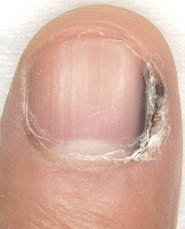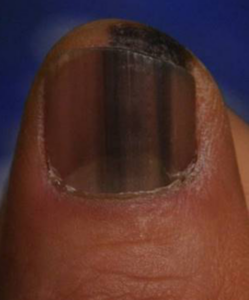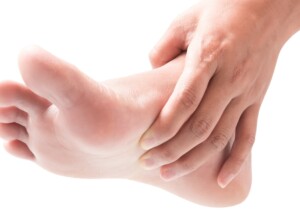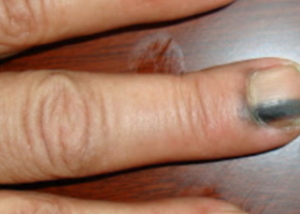If you see what appears to be Hutchinson’s sign in a fingernail or toenail, your first thought might be melanoma skin cancer.
However, Hutchingson’s sign can be caused by another type of malignancy, says Dr. Gretchen Frieling, MD, Triple Board Certified Boston Area Dermatopathologist.
Dr. Frieling explains, “Squamous cell carcinoma (SCC) of the nail bed is a rare malignant subungual tumor. It can be often misdiagnosed.”
Subungual melanoma is deadlier than subungual squamous cell carcinoma.
Subungual refers to beneath the nail, in the nail matrix, where this cancer, as well as melanoma, can begin growing.
Squamous cell carcinoma of the nail matrix, though rare, occurs more often than melanoma of this same tissue and is usually rather slow-growing.
This type of tumor is most prevalent in middle-aged men,” says Dr. Frieling. “Studies identify Caucasian men as most predisposed to bouts with this condition, and it can happen in the fingers or toes.”

Squamous cell carcinoma. Advances in Dermatology and Venereology Vol 89 Issue 6
SCC of the nail bed in a very early stage is called Bowen’s disease. And it can lead to a Hutchinson’s sign.
Keep in mind that benign conditions, too, can also cause what appears to be a Hutchinson’s sign.
A dermatologist needs to meticulously examine the area with a special magnifying lens to help guide in a proper diagnosis.
A biopsy may be needed, since sometimes – even under the magnifying lens – it’s not possible to distinguish between a benign and malignant condition.
Just what exactly is a Hutchinson’s sign?
Whether with melanoma or squamous cell carcinoma, Hutchinson’s sign is when the malignant cells start spreading to the skin around the nail.
The cancer, then, isn’t just in the nail matrix at this point. It can be either in the cuticle, the skin around the cuticle, and/or the skin along the side or the top of the nail.
The image at the top shows Hutchinson’s sign from melanoma (The Journal of Dermatology Vol 44, Issue 3).
Subungual melanoma affects blacks, Native Americans and Hispanics more than it does whites and has not been linked to sun exposure.
Subungual SCC, too, has not been tied to sun exposure, but 60 percent of cases are associated with HPV: human papilloma virus, perhaps via genital-finger transmission.
“When it comes to suspicious subungual hyperpigmentation or dark spots, it is incredibly important that you consult your doctor,” says Dr. Frieling.
“Sometimes patients think it is just a bruise from a stubbed toe they probably can’t remember stubbing.
“But if the dark mark does not subside and inversely becomes larger, getting it checked is a must.”


 Dr. Frieling’s website is
Dr. Frieling’s website is







































